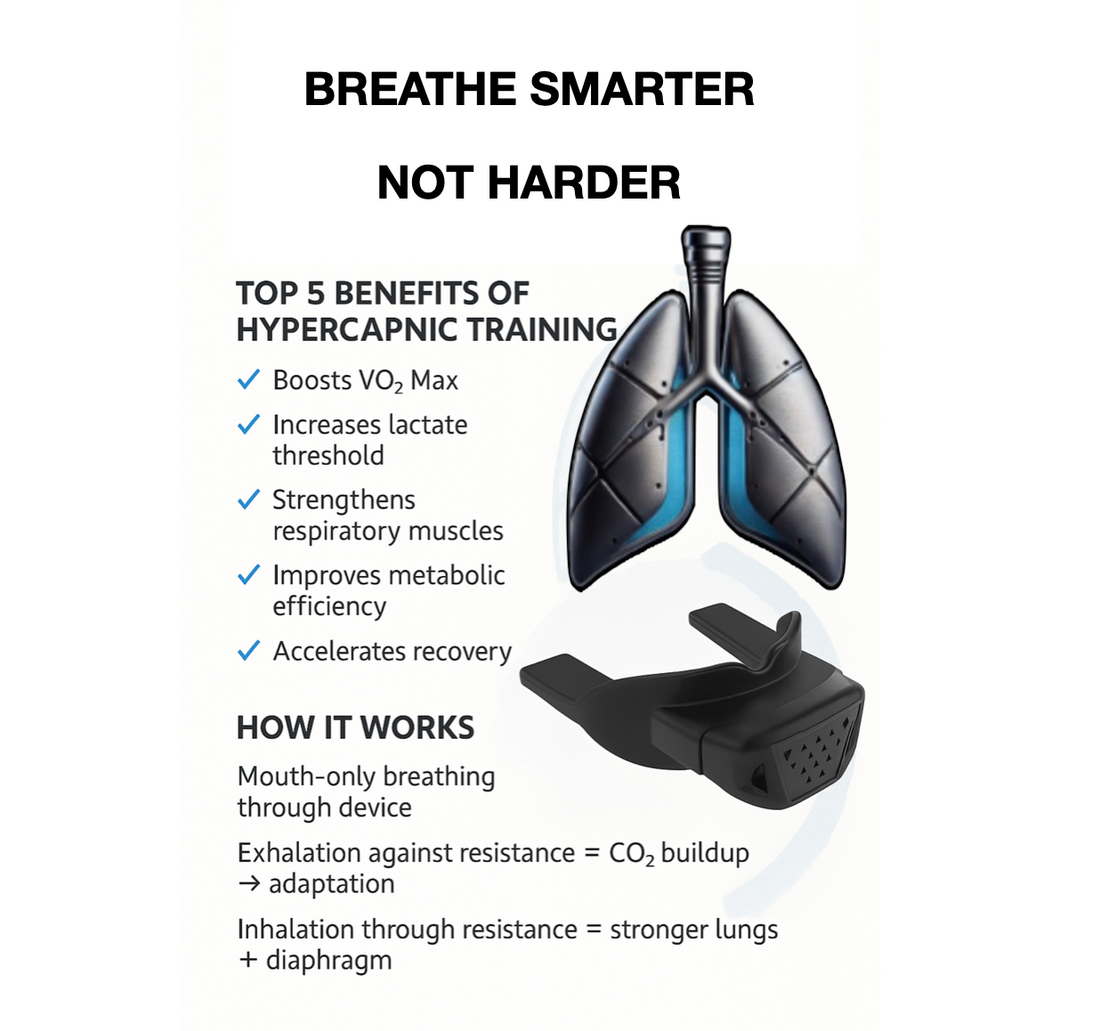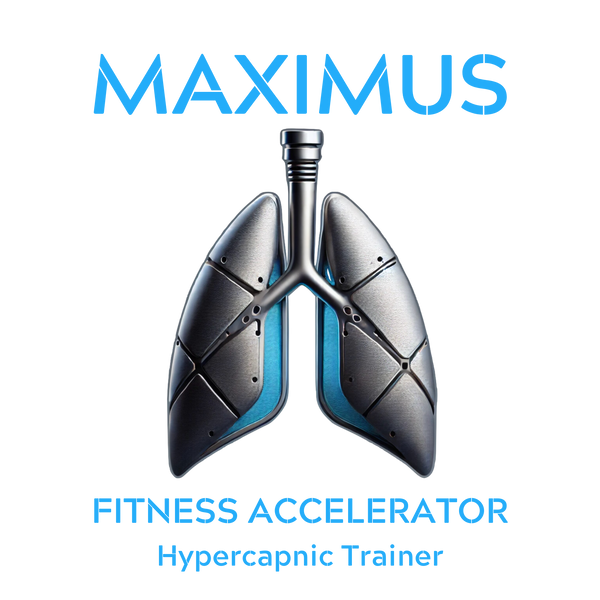
What's a Hypercapnic Training Device? How Does it Work?
Share
What Are Hypercapnic Training Devices?
Hypercapnic training involves intentionally retaining CO2 during exercise by restricting exhalation, which increases CO2 levels in the blood. This stimulates adaptations in respiratory muscles, enhances lactate metabolism, and improves cardiorespiratory efficiency. The concept is grounded in the idea that controlled CO2 retention trains the body to tolerate higher CO2 levels, improving oxygen delivery to muscles and delaying the onset of fatigue. Devices designed for this purpose typically provide resistance to breathing, either during inhalation (inspiratory muscle training, IMT), exhalation (expiratory muscle training, EMT), or both, focusing on expiratory resistance to maximize hypercapnic effects.
The science behind hypercapnic training is promising, particularly for athletes and individuals with respiratory impairments. Studies suggest that respiratory muscle training (RMT) can improve VO2 max, lactate threshold, and exercise endurance by strengthening the diaphragm and intercostal muscles. This could translate to tangible performance gains for athletes, such as faster sprint times or improved stamina. For non-athletes, benefits like better stress management, sleep quality, and lung function are compelling, especially for aging populations or those with conditions like COPD or asthma. However, the evidence is not universally conclusive, and some studies show heterogeneous results due to variations in training protocols, populations, and devices.
A critical concern is the limited adoption and standardization of these devices. Many RMT devices focus solely on inspiratory resistance, and only a few offer dual resistance, which is critical for maximizing hypercapnic effects. Overuse or improper use could also lead to overtraining or discomfort, and there's a risk that poorly designed devices might not deliver consistent resistance or could be unsafe if they overly restrict airflow. Additionally, while devices like those from trainmaximus.com claim significant gains (e.g., 25% increase in endurance, 36% in strength after eight weeks), these results often come from prototype testing on non-elite athletes, which may inflate perceived benefits. More rigorous, independent studies are needed to validate claims across diverse populations.
Overall, hypercapnic training devices have potential but are not a one-size-fits-all solution. They're most effective when integrated into a well-designed training program with clear goals, proper technique, and gradual progression. They could be a valuable tool for enthusiasts or athletes willing to invest time and effort, but casual users might find the learning curve and cost prohibitive without guaranteed results.
Devices Providing Dual Airflow Resistance | Inspiratory and Expiratory
Dual airflow resistance devices are designed to challenge both inspiratory and expiratory muscles, which is crucial for hypercapnic training since expiratory resistance drives CO2 retention. Based on available information, the following devices offer dual resistance and are suitable for use during exercise or as standalone trainers:
Description: The MAXIMUS device (trainmaximus.com) uses Dual Airflow Resistance Technology (DART) to provide adjustable resistance for inhalation and exhalation. It's designed to be worn during exercise, promoting hypercapnic training by increasing CO‚ÇÇ levels gradually. It's marketed for athletes and health-conscious individuals aiming to improve VO2 max, lactate threshold, and overall respiratory efficiency.
Features: Ergonomic design under face masks, adjustable resistance levels, and a focus on deep diaphragmatic breathing. It's claimed to be the world's first dual-resistance device specifically for exercise.
Reported Benefits: Prototype users reported a 25% increase in endurance and 36% in strength after eight weeks, with individual anecdotes citing up to 40% strength gains and improved cycling performance (e.g., 30% faster sprint times. Only MAXIMUS was designed from the ground up for use during exercise.
The Breather Description: A handheld RMT device that independently trains both inspiratory and expiratory muscles with adjustable dial controls. It's used by athletes, individuals with respiratory conditions (e.g., COPD, asthma), and those with swallowing or speech issues. It mimics pursed-lip breathing to clear airways and improve cough strength.
Features: Portable, clinically validated, and drug-free. It's suitable for standalone use but can be used during light exercise. It's particularly noted for improving lung capacity and supporting dysphagia treatment.
Reported Benefits: Users with emphysema reported reduced oxygen dependency and better endurance, while athletes noted enhanced respiratory performanc
WellO2: Description: To moisturize airways, a clinically proven device combining dual-resistance breathing (inspiratory and expiratory) with warm steam inhalation. It's designed for respiratory health, stress reduction, and voice endurance, and can be used via mouth or a nasal mask.
Features: Adjustable resistance, steam temperature options, and a cleaning program for multiple users. It's marketed for wellness and clinical use, focusing on reducing breathlessness and improving sleep quality.
Reported Benefits: Up to 20% increase in respiratory muscle strength in a month, reduced snoring, and improved immune function during flu seas
Airofit Pro 2.0: Description: A smart breathing trainer with dual resistance for inspiratory and expiratory muscles and a mobile app for guided exercises and progress tracking. It's designed for athletes and health-focused individuals but is typically used at rest rather than during exercise.
Features: Bluetooth connectivity, 17 training programs, and advanced lung capacity tracking. Unlike elevation masks, it emphasizes controlled resistance to avoid unsafe CO2 buildup.
Reported Benefits: Improved respiratory muscle strength and endurance, potential benefits for athletic performance, and general well-being.
Future Outlook for Hypercapnic Training Devices
The current use of hypercapnic training devices is niche, primarily among athletes, fitness enthusiasts, and clinical populations with respiratory conditions. However, several factors suggest a growing role for these devices in the future, tempered by challenges that need addressing:
Growing Interest in Respiratory Health:
There's heightened lung health awareness after COVID-19, and RMT devices are being studied for post-COVID rehabilitation. This could drive demand for dual-resistance devices in clinical and home settings.
Aging populations and rising rates of respiratory conditions (e.g., COPD, asthma) may increase adoption of non-athletic wellness devices, especially those like WellO2 that combine RMT with airway-clearing features.
Athletes increasingly seek marginal gains, and RMT's ability to improve VO2 max and lactate threshold aligns with this trend.\
Technological Advancements:
Smart devices like Airofit Pro 2.0, with app integration and real-time feedback, point to a future where RMT devices become more user-friendly and data-driven. This could make them more accessible to casual users.
Innovations in wearable design, such as MAXIMUS's ergonomic fit for exercise, suggest that future devices may integrate seamlessly into sports gear or fitness routines.
Combining RMT with other modalities, like WellO2's steam inhalation, could broaden appeal by addressing multiple health needs (e.g., mucus clearance, immune support).
Challenges and Limitations:
Limited Evidence: While some studies support RMT's benefits, protocol variability and small sample sizes limit generalizability. Larger, standardized trials are needed to establish efficacy, particularly for dual-resistance devices during exercise.
Adoption Barriers: High costs, learning curves, and the need for consistent use may deter casual users. Devices must become more affordable and intuitive to gain mainstream traction.
Safety Concerns: While these Hypercapnic training devices are generally recognized as safe, acclimation and overexertion can negatively impact training results. Improper use during exercise could lead to excessive CO2 retention or respiratory fatigue, necessitating clear guidelines and safety features.
Market Fragmentation: The RMT market has single-resistance devices and rare dual-resistance options. This fragmentation could confuse consumers and slow the adoption of hypercapnic-focused devices.
Future Predictions: Integration with Wearables: Future devices may sync with fitness trackers to provide real-time respiratory metrics, optimizing training intensity and duration.
Clinical Expansion: Dual-resistance devices could become standard in pulmonary rehabilitation, especially for conditions requiring both inspiratory and expiratory strength (e.g., stroke, neuromuscular diseases).
Mainstream Fitness: As awareness grows, hypercapnic training could be incorporated into gym routines or sports training programs, especially if devices become more portable and exercise-compatible.
Personalization: Advances in AI could enable devices to tailor resistance levels and training protocols to individual fitness levels and goals, improving outcomes and user engagement.
Where Does trainmaximus.com (MAXIMUS) Rank Among Devices?
The MAXIMUS device from trainmaximus.com stands out as a unique player in the RMT market due to its focus on dual airflow resistance and exercise-specific design.
Strengths of MAXIMUS: Exercise Integration: MAXIMUS is explicitly designed for use during exercise, unlike The Breather or Airofit, which are primarily standalone or used during light activity. This aligns with research suggesting greater cardiorespiratory gains when RMT is combined with exercise.
Dual Resistance: One of the few devices offering adjustable inspiratory and expiratory resistance, critical for hypercapnic training. Its DART technology is marketed as the first-of-its-kind for exercise-specific dual resistance.
Performance Claims: User reports of significant strength (up to 40%) and endurance (25%) gains, along with anecdotal improvements in cycling and wattage output, are compelling, though based on prototype data.
Ergonomic Design: Its ability to be worn comfortably under face masks and during sports makes it practical for athletes training in real-world conditions.
Weaknesses of MAXIMUS: Limited Independent Validation: Unlike The Breather or WellO2, which cite clinical studies, MAXIMUS relies heavily on prototype user data and anecdotal testimonials. Independent, peer-reviewed studies are needed to substantiate claims.
Market Presence: MAXIMUS is a newer entrant than established brands like POWERbreathe or The Breather, which have broader recognition and clinical backing.
Price and Accessibility: The sources do not provide pricing details, but if it's comparable to high-end devices like Airofit ($300+), it may face adoption barriers. The website redirects to x.ai, suggesting potential availability issues or a pivot in focus.
Competition: WellO2's steam inhalation and Airofit's smart app offer additional features that MAXIMUS lacks, potentially making them more appealing for wellness or tech-savvy users.
Ranking Among Dual-Resistance Devices:
Top Tier for Exercise Use: MAXIMUS likely ranks at or near the top for athletes seeking a device for hypercapnic training during exercise due to its dual-resistance, exercise-specific design. It's uniquely positioned against The Breather, which is more clinical, and Airofit, which is rest-focused.
Mid-Tier for Broader Appeal: For non-athletes or clinical users, WellO2 and The Breather may rank higher due to their additional features (steam, clinical validation) and established use in rehabilitation.
Needs More Validation: MAXIMUS's lack of widespread clinical or independent research places it behind The Breather and WellO2 regarding evidence-based credibility. Although less exercise-focused, Airofit's tech integration gives it an edge for tech-savvy users.
Ranking Summary: MAXIMUS is a strong contender for exercise-specific hypercapnic training, likely ranking #1 or #2 among dual-resistance devices for athletes, but it falls to mid-tier (behind The Breather and WellO2) for broader applications due to limited validation and market presence. Its future success will depend on independent research, pricing competitiveness, and sustained availability.
Conclusion and Recommendations: Hypercapnic training devices hold significant potential for improving athletic performance, respiratory health, and quality of life, but a lack of standardization, variable evidence, and niche adoption limits their current use. Devices like MAXIMUS, The Breather, WellO2, and Airofit lead the dual-resistance market, with MAXIMUS excelling for exercise-specific applications but needing more rigorous validation to compete with established players. With growing interest in respiratory health and technological advancements, the future looks promising, but challenges like cost, safety, and evidence gaps must be addressed.
For those considering a device: Athletes: MAXIMUS or Airofit Pro 2.0 are top choices, with MAXIMUS better for exercise integration and Airofit for guided training.
Clinical/Rehabilitation Users: The Breather or WellO2 are safer bets due to clinical backing and additional features.
General Wellness: WellO2's steam inhalation makes it versatile for daily use, while The Breather is cost-effective and widely trusted.
Before purchasing, consult a healthcare or fitness professional, especially if you have pre-existing conditions, and start with lower resistance to avoid overtraining.
The Breather and the WellO2 devices. They are not made to be used during exercise. This is a key point of delineation. WellO2 devices are not made to be used during exercise. This is a key point of delineation.
Thank you for clarifying the key distinction that The Breather and WellO2 are not designed for use during exercise, unlike devices like MAXIMUS from trainmaximus.com, which is explicitly marketed for exercise-integrated hypercapnic training. This delineation is critical when evaluating hypercapnic training devices, especially for athletes or users prioritizing respiratory muscle training (RMT) during physical activity. Below, I'll address your original questions with this distinction in mind, focusing on hypercapnic training devices, dual airflow resistance, the future of such devices, and the positioning of MAXIMUS, while incorporating the updated context about The Breather and WellO2.
